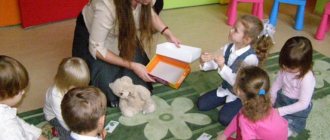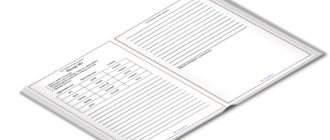Determination of the level of speech development according to the method of O. A. Bezrukova, O. N. Kalenkova
Yulia Savinova
Determination of the level of speech development according to the method of O. A. Bezrukova, O. N. Kalenkova
The success of correctional work depends on the results of the diagnostic examination. Examination is the first and very important stage of training. Determining the level of speech development of a child is one of the most pressing topics in a number of scientific disciplines, one way or another related to the problems of training and education of the younger generation: preschool pedagogy, linguodidactics, defectology in general and speech therapy in particular,
The ability to speak language and speech is extremely important in the life of every person. It is necessary for the child’s normal entry into society, his upbringing, education, personality development, i.e. sociocultural adaptation. Permeating all spheres of human life without exception, speech is the key to the full development of each of them . Timely identification and competent interpretation speech abilities make it possible to effectively solve a whole range of educational, developmental and correctional tasks, since the state of speech is an important diagnostic sign of the child’s general mental development
After analyzing the existing scientific literature, we identified two leading directions in the study of speech: neuropsychological and psycholinguistic. Neuropsychological is based on the fact that for normal speech formation it is necessary that the cerebral cortex reaches a certain maturity , the articulatory apparatus is formed and hearing is preserved.
of speech pathology were developed and adopted , in one of which violations of the external (phonation, side of speech were separated from violations that arise at earlier stages (clinical and pedagogical classification), and in the other, violations of the acquisition of means of communication are opposed to violations application of these means (psychological - pedagogical)
.
Because speech therapy examination is a technology of the science of speech therapy, it has its own principles.
1. The principle of a comprehensive study of a child - a comprehensive examination of the developmental features of all types of speech activity . A psychologist, otolaryngologist, ophthalmologist, speech therapist, teacher of the deaf, mental health teacher, etc. take part in the examination.
2. The principle of a holistic systemic study of a child - a holistic analysis in the process of speech therapy research involves not detecting individual manifestations of speech development , but establishing connections between them. Fundamental here is Vygotsky’s position on the structure of the defect.
3. The principle of dynamic study of the child - during the examination, it is important to find out not only what children know and can do, but their learning capabilities. Significant is Vygotsky’s concept of the relationship between learning and development , according to which the zone of actual development ( the level of difficulties solved by the child independently)
and the zone of proximal
development ( the level of difficulties solved under the guidance of adults).
4. The principle of a qualitative-quantitative approach - when analyzing data, it is important to take into account not only the final result of the activity, but also to analyze the process of its implementation - the method, rationality, logical sequence of operations, persistence in achieving the goal.
The effectiveness of correctional speech therapy work is based on the results of a diagnostic examination. Currently, there are many methods for studying the level of speech development of a child , including verbal and test tasks. They have a different number of stages, and the examination may vary over time periods. There are techniques for examining children with specific speech disorders . For example, dysarthria, rhinolalia, stuttering. There are also different approaches to processing and interpreting the results. All these methods are aimed at studying a child with a certain level of speech development , taking into account age norms.
When examining children in our preschool institution, we use the method of determining the level of speech development of preschool children by Olga Aleksandrovna Bezrukova and Olga Nikolaevna Kalenkova .
The innovation of the method lies in the fact that it gives an objective idea of the level of speech development of a child based on quantitative and qualitative indicators. The test results provide both a general assessment speech development in points relative to the maximum possible, and a detailed descriptive description of individual parts of the speech-language mechanism . The technique is intended to determine the level of speech development of children from 3 to 7 years old . It is accompanied by:
— a methodological manual by the authors with a description of the technology for conducting and processing the results of an examination of children’s speech,
— a methodological manual by the authors describing the technology for conducting and processing the results of an examination of children’s speech;
- methodological recommendations for the design and maintenance a speech card - the main document in the work of a speech therapist;
— illustrative material of excellent printing quality for test tasks for each age group.
— CD with protocols for examining the speech of children of different ages, summary tables of the results of examining the speech of children and a speech card .
Structure of the methodology .
The method consists of 4 blocks , each of which contains test tasks.
Block 1. The main goal of the test tasks in this block is to determine the volume of the vocabulary and the variety of connections (semantic and formal)
between lexical units
(9 tasks)
Block 2. The main purpose of the test tasks in this block is to determine the level of grammatical competence. The main criterion for assessing grammatical competence is the development of inflectional and word-formation skills and abilities (9 tasks)
Block 3. The main purpose of the test items in this block is to assess phonological skills and abilities. This assessment consists of the results of a survey of phonemic processes, skills of sound analysis and synthesis, phonetic design of speech (6 tasks)
Block 4. The main goal of the tasks in this block is to assess the level of formation of a coherent speech utterance (text activity, which develops as a result of a cumulative analysis of understanding and independent production/reproduction of a text of a narrative nature in accordance with the proposed plot. (4 tasks)
All test tasks are documented in the Examination Protocol, presented in the form of an Excel document, which allows you to quantify the percentage of tasks completed by the child and the maximum determined by the protocol .
Each test task is assessed in points, then the total percentage for completing all tasks of the methodology . The results of the examination based on the Protocol are compiled in a summary table for each child, which shows the characteristics of individual parts of the speech-language mechanism in points relative to the maximum possible. The speech drawn up based on the results of the examination protocol and summary table. The methodological recommendations for maintaining a speech card for a preschool child clearly show the structure and content of a speech card for preschool children. It has two forms (Form 1 - a child of early and primary preschool age)
and Form 2 – child of middle and senior preschool age. Clear formulations of conclusions under the relevant headings are given.
Block A. Formal information: last name, first name of the child, his age, date of examination; last name, first name, patronymic of parents or legal representatives; last name, first name, patronymic of the speech therapist; name of the institution where the examination is carried out.
Block B. Main content of speech therapy examination:
1. The child’s general ideas about the world around him
2. Speech-language competence
2.1. Level of vocabulary development
2.2. Level of grammatical competence development
2.3. Understanding and independent production/reproduction of narrative text in accordance with the proposed plot (story/retelling)
2.4. Level of formation of phonetic-phonological competence (sound discrimination, sound analysis and synthesis)
3. State of the articulatory apparatus
4. Prosodic speech design
5. Motor development
5.1.When studying basic motor skills and the coordination area, the following are subject to assessment:
5.2. Formation of purposeful movements (bodily praxis)
assessed based on studying:
6. Psychological basis of speech
The psychological basis of speech is understood as the state of those areas of the psyche that provide speech understanding/speech production and are directly involved in these processes. Assessment of the psychological basis of speech is carried out on the basis of a cumulative analysis of verbal memory, speech attention , and thinking.
Block B. Additional information.
1. Features of early speech development
2. Features of the speech environment in which the child was raised and is being raised
3. Features of speech behavior
4. Neurological status and state of sensory-perceptual organs and systems
5. Information about current and past diseases
Block G. Speech therapy report
A speech therapy report necessarily includes unified nomenclature designations for one or another form of speech pathology . In the method of Olga Aleksandrovna Bezrukova, the results are not directly related to the level of speech development and therefore we correlated the points scored by the child with the level of his speech development , using the test method . ped. Sciences, speech therapist Akimenko Valentina Mikhailovna.
Examination procedure:
1. Preparation of material for the survey (protocols, summary tables, speech cards , illustrative material).
2. Survey work. It is carried out by two specialists (the first one examines, the second one records the examination results in an electronic protocol). Each child is examined in three approaches (for 15 minutes each)
.
3. Processing of received data in protocols, filling out summary tables.
4. Preparation of speech cards with a speech therapy report.
5. Determination of a correction route for each child.
6. Drawing up a summary table for the entire group of children.
When conducting the survey, we can identify the following difficulties:
1. Lack of multimedia equipment (computer, printer)
.
2. Cumbersome examination (up to 3 sheets of protocol + 3 sheets of speech card + digital table, time-consuming.
3. Study of manuals explaining the examination technology and the process of filling out the document.
4. It is inconvenient to examine and simultaneously fill out a protocol electronically
Positive points:
1. Provides results for all components of the speech system in a visual form immediately after the examination (visualization of examination results)
.
2. Speech therapy conclusions, which are most often found in speech therapy practice, are correctly formulated; simplify filling out documents, maintaining their content and correctness. 3. A summary table of results allows you to create an individual correction route in more detail and with high quality.
4. It is convenient to create a summary table for the entire group, clearly reflecting the overall picture of the group’s speech development . 5. Electronic documents allow you to organize your work more efficiently.
6. The result of the work on correcting speech disorders of preschoolers is visible in dynamics (from the beginning to the end of the year, as well as the dynamics of the development of each child and group of children over several years.
7. The information obtained can be used in compiling a portfolio for certification of the professional activities of a speech therapist teacher.
We have been using this technique in our work for two years. We recommend it for teachers – speech therapists working in correctional groups. Good luck in job!
Ebbinghaus technique.The technique is used to identify the level of speech development and the productivity of associations. Instructions: “Fill in the missing words.”
Instructions : “Place the dots.”
Analysis of results: The speed of finding and productivity of associations is recorded.
A technique for studying the possibility of comprehending a situation based on auditory or visual perception (understanding the explicit and hidden meaning, the connection of details into a single whole).
This technique is used to determine the level of development of understanding of grammatical structures.
Task 1. 1. “Listen to what I read to you and tell me.” 2. “Read and retell.”
Jackdaw and dove.
The jackdaw heard that the pigeons were well fed, turned white and flew into the dovecote. The pigeons accepted her as one of their own and fed her, but the jackdaw could not resist and croaked like a jackdaw. Then the pigeons drove her away. She went back to the jackdaws, but they didn’t accept her either.
Ant and dove.
The ant wanted to drink and went down to the stream. The wave overwhelmed him and he began to drown. A dove flying by noticed this and threw a branch into the stream for him. The ant climbed onto this branch and escaped. The next day the ant saw that the hunter wanted to go and catch the dove in a net. It crawled up to him and bit him on the leg. The hunter screamed in pain and dropped his net. The dove fluttered and flew away.
Smart jackdaw.
The jackdaw wanted to drink. There was a jug of water in the yard, and the jug only had water at the bottom. Jackdaw was out of reach. She began throwing pebbles into the jug and scattered so many that she could drink.
Most beautiful.
An owl was flying. Other birds flew towards her. The owl asked: “Have you seen my chicks?” - What are they like? - Most beautiful!
Analysis of results: understanding of the sequence of events, general and hidden meaning is taken into account.
Task 2.
Addressing the child, the teacher says: “Listen carefully. I will name a few words. Make up several sentences from each set (one sentence). If necessary, change these words or add one or more words to the set.”
Sets of words: 1. Girl, album, drawing. 2. Child, cup, milk. 3. From, cage, siskin. 4. Sasha, skiing, riding, on.
Grading scale.
| 4 or more | 5 |
| 3 | 4 |
| 2 | 3 |
| 1 | 2 |
| 0 | 1 |
Task for in-depth diagnostics.
“Listen to a series of words and make sentences from them.” 1. Girls sing in the choir. 2. Passengers on the tram get off.
Task 3.
Two cards with pictures are laid out on the table in front of the child:
The teacher says: “The boy in the white shirt is called Petya, and the boy in the checkered shirt is Vanya.” Then, under these pictures, the teacher lays out eight separate cards with sentences of varying syntactic complexity printed on them. These sentences represent a description of situations in which the subject of the action is either Petya or Vanya (active and passive constructions): Vanya drew Petya. Vanya was drawn by Petya. Petya was drawn by Vanya. Vanya is drawn by Petya. Petya drew Vanya. Petya is drawn by Vanya. Petya is drawn by Vanya. Petya is drawn by Vanya.
Then the teacher says: “Read these sentences. Put separately those that say what Petya drew, and separately those that say what Vanya drew.”
Note: If the child does not read, deictic gestures are used. The teacher reads the sentences. The child shows with his finger who drew: Petya or Vanya.
Task for in-depth diagnostics.
“Show me where in the picture: - the circle under the square; - a square over a circle; - circle on a square; - a circle over a square."
Phoneme discrimination and selection test.
The sound discrimination test consists of 8 basic tasks and 6 tasks for in-depth diagnostics. The first and second of the main tasks are aimed at assessing phonemic perception, the third and fourth - at the state of phonemic representations, the fifth, sixth and seventh - phonemic analysis and the eighth - phonemic synthesis.
To assess the state of phonemic perception, the complex includes tasks aimed at recognizing, distinguishing and comparing: individual sounds in a series of sounds (task 1) and synonymous words (task 2). Particular attention in the tasks is paid to the distinction between whistling and hissing, affricates of voiceless and voiced, hard and soft phonemes. If necessary, additional tasks can be used for this purpose.
At the time of using this test, it is necessary to have data on the state of the child’s physical hearing. This is because even slight hearing loss in early childhood makes it difficult to distinguish speech sounds. At the same time, children with normal physical hearing often have specific difficulties in distinguishing subtle differential features of phonemes. These difficulties affect the development of the entire sound system.
Exercise 1.
Addressing the student, the teacher says: “Now I will name various sounds. Be careful: if among these sounds you hear the sound Ш, then raise your hand. Listen:
T, Sh, Ch, F, Shch, Sh.”
After the student completes this part of the task, the teacher continues the instructions: “Now raise your hand when, among the sounds that I will pronounce, you hear the sound 3′ (зъ). Listen:
S', C', 3′, T', 3' ". And finally, the teacher says: “Now I will again name the various sounds. Raise your hand only when you hear the sound T. Listen:
S, Ch, T, C, S, C, Shch.”
Note: The sounds Ш, 3′, Ц occur twice in given rows of sounds. Therefore, the total number of correct answers is six. Based on this, the following assessment standards are proposed.
Task for in-depth diagnostics.
“When you hear the syllable TA among other syllables, raise your hand. Listen: YES, NA, TA.” After the child gives the answer, the teacher continues: “Now raise your hand if you hear the syllable SY. Listen:
ZYA, XYA, SA, XYA, TYA.”
Task 2.
10 drawings are laid out on the table in front of the child (see below). Next, the teacher says: “Look at all the pictures and tell me, are all the objects depicted in the pictures known to you? Do you know the names of all these items? (Usually the child answers in the affirmative.) Now be especially careful. I will show these objects in pairs (two words each), and you will show them in the drawings.” Next, the teacher names the following pairs:
grass - firewood, duck - fishing rod, roof - rat, bear - mouse, barrels - kidneys.
Task 3.
The teacher lays out the pictures below on the table in front of the student (with the exception of two pictures with houses). The names of the objects that are depicted in these pictures contain either the sound D or the sound T. Next, the teacher asks: “Do you know all the objects?” The child usually answers in the affirmative.
Then the teacher lays out two more pictures: the first one shows a white house, the second one shows a black one. The teacher turns to the student again: “Place pictures of objects with the sound T near the white house, and pictures with the sound D near the black house.”
Task 4.
Addressing the student, the teacher says: “Remember and name as many words as possible that contain the sound S. Remember that this sound can be at the beginning of a word, in the middle, at the end.”
Task 5.
First, the teacher asks the child to write the word on a piece of paper
"frying pan".
As a rule, the student refuses to do this, citing inability to write well. The teacher calms him down, saying: “Well, then we will do things differently. I will write down the words. To do this, you will first dictate to me the first sound in the word, then the second, third, and so on until the end of the word. But we will start with a short word, and then we will take words that are longer and more complex.”
Then the teacher calls out the words one by one:
nose, spider, school, tent, frying pan.
Task for in-depth diagnostics.
“Name the first and last sound in the word
ELEPHANT".
Task 6.
Four cards are laid out on the table in front of the child (see below). The teacher asks whether the student knows the names of the objects depicted on them and asks them to name them. Then, turning to the student, he says: “Select from these four pictures the one in whose name the first sound is the same as in the word “swallow.”
Task for in-depth diagnostics.
“Choose from among the pictures the one that begins with the sound B.”
Task 7.
The teacher places four letters on the table in front of the child:
H W T
Checks to see if the child knows what letters these are and asks to name them. Then the teacher says: “Now I will say one word - the word “cup.” And you select from these four letters (SH, CH, C, T) the one that corresponds to the first sound of this word.”
Task for in-depth diagnostics.
“Choose from four letters the one with which the word AIST begins.”
O U A M
Task 8.
Addressing the student, the teacher says: “Now I will name each sound in the word separately, one after the other. Listen carefully and say what word comes out of these sounds.” (The teacher pronounces sounds at intervals of 4-5 seconds.)
Task for in-depth diagnostics.
“Tell me what word will come out of the sounds that I pronounce.” (Sounds are pronounced at intervals of 2-3 seconds.)
“Name the first sounds in the words that indicate the names of the objects depicted in these pictures.”









